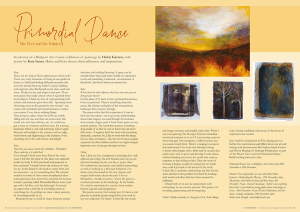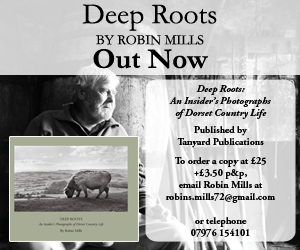In advance of a Bridport Arts Centre exhibition of paintings by Helen Garrett, with poetry by Kate Innes, Helen and Kate discuss their influences and inspirations.

Kate:
Helen, how has living in Dorset influenced your artistic work?
I have very early memories of being in our garden at home as a child and finding different materials that were left around from my father’s various building and carpentry jobs. Reclaimed wood, slate, sand and stone. I’d dig out clay and shape it into pots. There were plants that made colours when I squished them in my fingers. I think my love of experimenting with colours and materials grew from this. Spending hours observing, close to the ground is very visceral – you witness life and death and transformation, it makes you curious. I was always making things.
Also, living in a place where the cliffs are visibly falling into the sea, and there are ammonites that startle you with how old they are. As a child you get a sense of evolution and time here. It’s a strong landscape which is soft and nurturing, full of apple blossom and sunlight in the summer and yet edgy, wind-blown and frightening in the darkness. I was absorbing all of this with horror and delight.
Kate:
How have you come to create this exhibition – Primordial Dance and why is it called that?
Even though I lived away from Dorset for some years, I felt that the print of this place was captured inside my body. It feels profound and poignant to have returned. I wonder about the essence of what we are. Is this linked to the land we come from and our ancestors…or is it something else? My artwork touches on some of these more metaphysical ideas and experiences that seem to be universal for humans.
I made a painting called Primordial Dance some years ago and it felt like a real breakthrough. It seemed to express that a little bit of everything exists in everything else. So perhaps we carry a deep memory of everything inside of us.
Painting for me is a kind of dance between action/intention and yielding/listening. A space can be created where inner and outer worlds of experience touch and something is released—transformed. A threshold. And that’s where my interest lies.
Kate:
What about the other influences that have come into your art through your travels?
Certain places I’ve been to have profound resonance, Crete in particular. There’s something about the music, the colours and spirit of the mountainous landscape that connects strongly.
I’m curious what that felt connection is. I start to look into the culture—try to get some understanding about what imagery was used through the centuries, what animals, shapes, gods. I think there’s power in very ancient artefacts. The symbolism touches something deep inside of us that we sort of know but can never fully know—I suppose that’s the same with everything, ultimately, a mystery. So, I like to work with the things that we share as humans—like the love between people, or parents for their children and how we might navigate important rites of passage through our lives.
Helen:
Kate, I know you have a background in archaeology that’s really influenced your writing. You write historical novels, but you also distil your knowledge into just a few lines of poetry. How?
I’ve worked on excavations and studied archaeology, as well as working as a Museum Educator. I’ve always been fascinated by the way objects and images hold stories about the past. I live in Shropshire—border country—where the past is a constant presence in the landscape. In my books, I’ve tried to reanimate the remains from written history, legends and imagination.
But poetry was my first writing love. It’s been a real pleasure to include poems inspired by your work in my new collection The Matter. It feels like the words and images resonate and amplify each other. When I saw your painting The Messenger, I had an immediate emotional response to it, as if I was meeting a person from long ago. One recognises a fellow human, but you cannot reach them. There’s a longing to connect and understand. I try to do that through writing.
A poem often begins with a little seed of an idea that needs some time to grow and develop. I write down, without thinking too much, the words that come in response to that feeling or idea. Then the work of forming it begins, usually by cutting lots of words away until I get back to the kernel of the truth.
It feels like a symbiotic relationship, not that I’m the artist and that is the product, but that I’m working with words and ideas that have been around for millennia.
I think both of us can see connections with archaeology in our creative practice. The process of revealing, appreciating and investigating.
Helen: I think curiosity is a big part of it. And taking risks. Having confidence that none of the hours of exploration are wasted.
Kate: And it’s exciting that we’ll be taking part in a further live conversation and Q&A about our art and writing with documentary film-makers Steph Farmer and Trevor Hearing of ArtScape Productions as part of the Private View event for Primordial Dance. Really looking forward to that.
Primordial Dance runs at Bridport Arts Centre from 28th November to 20th December.
Private View and premiere of new artist film: Helen Garrett—Befriending the Mystery, 29th November, 6pm.
Masterclass with Helen Garrett and Kate Innes, 8th December, 11am. Ancient Hauntings: Author event exploring Kate Innes’ recent book for young people about archaeology on Crete, 20th December, 11am. Winter Celebration, with live music, readings and poetry, 20th December, 6pm.
Book events through www.bridport-arts.com




